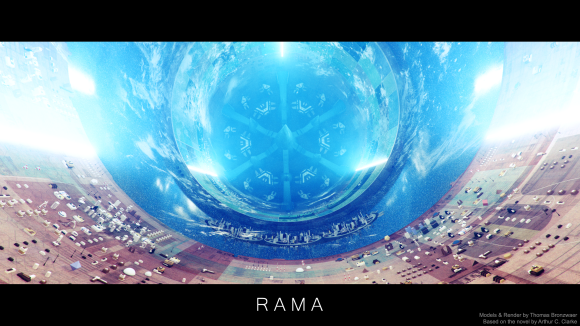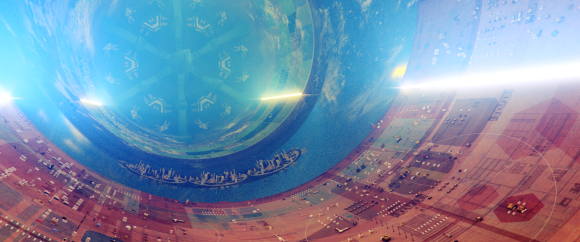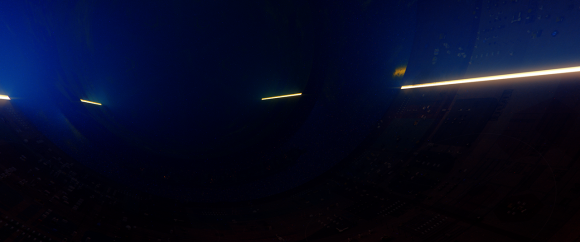Update Sept 2020: see this new blog post for Rama v1.0!
I’ve recently been reading some of the old Sci-Fi masters, and I really fell in love with Arthur C. Clarke’s ‘Rendezvous with Rama’. I’ve read it twice now and was completely engrossed both times – I can’t recommend this book enough! I decided I wanted to recreate the titular spaceship using CGI, and have been working on it occasionally in my spare time over the past few years.
In case you haven’t read the novel, Rama is an ancient, hollow, cylindrical spacecraft that is 50 km long. It contains a breathable atmosphere and its rotation provides artificial gravity on its inner plains, which are divided by a Cylindrical Sea that runs all around Rama. There are several clusters of buildings on the Raman plains, which are dubbed cities (although they are deserted and apparently not inhabitable), as well as six light emitting strips that function as artificial suns.
There are many beautiful interpretations of Rama on the net, which can be found with a simple Google image search. My own version is a mishmash of elements from many of these illustrations plus my own imagination; I’ve also tried to be very faithful to the book’s description.
I decided to reproduce Rama using a physically based ray tracer called Luxrender, which is available for free. Luxrender is capable of reproducing such optical effects as asymmetric volumetric scattering (which causes sunsets to be red in the real world), helping to recreate Rama’s atmosphere.

The above image shows the 3D model of Rama, which consists of triangle meshes. Below I’ve posted a close-up of some of the buildings I made for the ‘cities’. These images are not final renders, but rather previews of the geometry of the scene – no textures, lighting, or atmospheric effects are included.

Finally, I’ve posted two actual renders of the current state of Rama below. These took a few days to create, due to the computational expense of simulating light scattering through the atmosphere!
I’ll be working more on Rama – there are still many details left to add – so there’ll be updates in the future.
Click on the images to see the full size versions.
Minor update (12 April 2017) – new image added with a few more details:
And here are the old images:
Second update (28 April 2017) – new image added with a few more details:
Previously, I introduced my recreation of the giant interstellar craft Rama from Arthur C. Clarke’s novel Rendezvous with Rama. Since then, I’ve worked on it a bit more, and I thought this was a good time to post the current state of things. I also wanted to thank everyone who responded to the first post!
Without further ado, here is the latest version of Rama:
(Click on the image to open the full size version in a new tab)
Update May 24th: I did another pass on Rama’s atmosphere and updated the image.
Overall, the image is now much darker and less saturated by Rama’s lighting, which is almost always directly in view. This changes the mood of the image to something that, I think, suits the novel better. I shrunk the buildings in the foreground, as they were far too big (they were about half a km tall). I also made the atmosphere thicker, so it’s more prominent. Finally, I painted some additional details on the ground texture and updated some of the building materials.
One thing I want to point out in particular is the way the atmosphere scatters light; in Rama, as in the Earth’s atmosphere, blue light is scattered more strongly than red light. This is called Rayleigh scattering, and it’s the reason why the sky is blue, and why the sun turns red at sunset. We can see this phenomenon at work if we turn down the lights a bit in Rama:
Rama’s “six linear suns” (of which we can see four) emit white light, i.e. light of all colors. The blue light now gets scattered, which we can see happening near the light sources; we see a diffuse blue glow of light that gets scattered every which way. The sources themselves look sort of orange, because the reddish/orange-ish light is not scattered as much, and travels unobstructed to our camera. The reflection we see toward the upper right corner is very orange, because this reflected light travels a longer path than the direct light, allowing more blue to be scattered out of it.
That’s it for now! For the next update, I’ll focus primarily on adding the ‘craters’ in the southern plains (Copernicus and its companions), as well as upgrading the look and feel of New York (the big island).





22 replies on “Rendezvous with Rama”
Have you read James White’s All Judgement Fled (1968)? I find it a far better “big dumb object” (yeah, a great name for this type of sub-genre of SF) novel… It’s more about the psychology of the explores, and the hell they encounter. Recommended!
(but, I certainly loved Rendezvous as a kid!)
LikeLike
I haven’t read that one – I ordered a copy on Amazon, though it probably won’t arrive until May. Cheers for the tip!
Usually I am more interested in the thing that is being explored than in the explorers. That’s why I tend to love Arthur C. Clarke’s style, which has been described as “benignly indifferent to the niceties of characterization”. I’m certainly willing to give White a shot though – I also ordered his first Sector General book, which sounds cool too.
LikeLike
I am exactly the opposite — hence my general frustration with Clarke and his poorly drawn/realized characters — I am all about exploring the explorers than what they are exploring. The first third of All Judgement Fled encapsulates my drive in that regard — although, that said, the rest is also about what is being explored. And all the paranoia around the world watching their every move and how they have to maintain decorum despite the hell and terror they are experiencing…
LikeLike
Hey Joachim, I finally finished All Judgment Fled! I really enjoyed it – it’s obviously vastly different from Rendezvous with Rama, but I felt that there was plenty of emphasis on the thing being explored to keep me satisfied, and I was more than impressed with White’s presentation of the intelligent extraterrestrial species, always a supremely difficult job. Ironically, I felt that some of the psychological tension was the weakest part of the novel – here again I want to sing Clarke’s praise; I believe that human astronauts in such a situation would be far more competent and controlled (and thus boring from a story point of view), and I felt that the general speaking from Earth was almost farcical toward the end. On the other hand, I thought the emphasis on the psychology of some of the crew members did work from a story perspective. As I said, I enjoyed it a great deal – thanks once again for the tip!
LikeLike
I’m glad you liked it. Are you going to write a review?
LikeLike
That’s a fun idea, I just might!
LikeLike
Question: how is Rama inside Venus orbit and yet there is a 10 min communications gap?
LikeLike
Light from the Sun takes about 8 minutes to reach us and 6 minutes to reach Venus. That means that the communications delay between Earth and Venus can range from 2 to 14 minutes depending on the locations of the planets. Objects that are inside Venus’ orbit (and which are at least 2 light minutes away from the Sun) can have a distance of 10 light minutes to Earth, so Rama must have been between 2 and 6 light minutes from the Sun.
LikeLike
Enjoyed checking this out, thanks for sharing! – I just reread the Rama series after first reading it as a teenager 20 years ago. I was kind of surprised by how few renderings and visualizations of the rama spacecraft i found on the internet. Nice to find a recent one!
LikeLike
Great images! I would like to recommend a book called The High Frontier: Human Colonies in Space by Gerard K. O’Neill. I think O’Neill got some of his inspiration from Rama.
https://en.wikipedia.org/wiki/The_High_Frontier:_Human_Colonies_in_Space
LikeLike
Thanks for the comments guys! Micke, that book looks interesting – I love the cover, with its typical 70’s scifi look. I will try to check it out soon, although I have a pile of unread scifi books to get through at the moment. From the publication dates alone, it does seem that O’Neill was inspired by Rama, and one wonders why the concept is called an O’Neill cylinder…
LikeLike
Hello, Thomas 🙂 !
I’ve just finished the novel and recorded new episode of the podcast in which I share My impressions. I wonder if would be possible to reach full-size images of Rama (links aren’t work) – I mean those in this post and others – if You have any? It would be great to use them in the cover design of this episode. If You wouldn’t mind this, please contact Me via e-mail.
Regards!
Thomas Leigh
LikeLike
Hey there,
Thanks for pointing out that the links are broken… DropBox changed the way their public folder works. I will fix the links ASAP.
I’m happy that you want to use the images; as long as you give me credit for them, I’m fine with it! I will e-mail you the latest versions tonight.
Thomas
LikeLike
Thank You, it will be great! 🙂 Of course I will credit You with pleasure 🙂 .
LikeLike
Alright, I updated the post – the links should work again, and I added a slightly updated picture as well! Please post a link to your podcast here when it’s done 🙂
LikeLike
Thank You very much 🙂 ! Those illustrations are very interesting and appealing, I think they render the concept of world of Rama pretty well. It is definitely great that You’ve decided to envision and depict this. Amazing how much this novel inspired You to do it – over the years! 🙂 Congratulations!
Recently I’ve finished “Rendez-vous with Rama”, if You’ve read next books in the series – what do You think about them?
Also I’ve just published Your illustrations on My podcast website, being very happy that I can share them with others who appreciated “Rama”. Unfortunately the podcast is in Polish, but just in case here You are (the whole podcast is in essence on thoughts inspired by literature):
http://moliumpodcast.blogspot.com/2017/04/molium-38-rzut-oka-na-obcy-statek.html#post
Have a nice day! 🙂
Thomas Leigh
LikeLike
[…] a previous post, I introduced my recreation of the giant interstellar craft Rama from Arthur C. Clarke’s […]
LikeLike
i really enjoyed and appreciated your work its looks great more fantasy and colorful than it should be but looking more advanced extraterrestrial space craft. colors and light looks great and sharped very well i do believe if some one finally makes the movie it should be looking fresh and colorful as u created. here you can find more information about Rama and especially on the first book Rendezvous with Rama.
https://www.facebook.com/arthurcclarkeRama
LikeLike
Thanks Majid, I appreciate your comments!
LikeLike
Fantastic. Loved the series so much, and really wanted a desktop background to put up at work, and this was a fantastic option. Many people have walked by my desk and complimented my background, so all those compliments are owed to you. Many thanks for putting an image to a great story!
LikeLike
That’s awesome to hear, thanks a lot!
LikeLike
[…] been far too long – three years! – but it’s finally time for me to finish my depiction of Rama, the […]
LikeLike